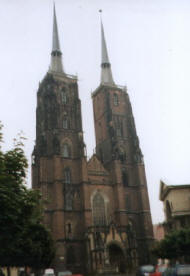|
Treasures of the Church- Holy Sites |
ST. JOHN THE
BAPTIST
Cathedral
of Warsaw
by SCTJM
Saint John the Baptist, Warsaw’s
Cathedral, whose first construction in wood, dates back to the XII
century, is one of the oldest churches in the city. In the XV
century, it was rebuilt in stone at the request of Duke Janusz I of
Masovia. During the Second World War, it was destroyed by several
fires and was rebuilt with its square tower in the original Gothic
style of Masovia. Saint John the Baptist was originally a parish,
and in 1798, it was designated as a Cathedral. Many important events
took place inside the Cathedral, such as the coronation of Stanislaw
August Poniatowski in 1764, and the resolution of the Great Sejm
(the Polish Parliament) of the Constitution in 1791.
In the interior, it holds objects of sacred art, among which the
baroque choir stalls stand out, and the baptismal font of black
marble is the original piece from 1632 made by Petrus Noire Gallus.
There are also epitaphs and tombstones which date back to the
XVI-XVII centuries, among which are the tombstones of Stanislaw and
Janusz, (Masovia’s last Dukes), Stanislaw Malachowski’s tombstone.
The crypts beneath the main aisle hold the remains of numerous
notable figures in the history of Poland.
In this place, one can also find the remains of Warsaw and Gniezno’s
Archbishop, Cardinal Stefan Wyszynski, who was also the Primate of
Poland. He was associated with John Paul II. During the regime of
Gierek, in 1976, both of them urged the workers and the government
to work together towards a reconciliation, in the midst of riots and
diverse political problems in Poland. At that time, Venerable John
Paul II was the Archbishop of Krakow, then known as Cardinal Karol
Wojtyla. Just like John Paul II, Cardinal Wyszynski was also devout
to Saint Louis-Marie Grignion de Montfort, and he firmly believed in
the power of consecrating oneself to the Mother of God.
On September 25th, 1953, Cardinal Wyszynski was arrested because of
his strong defense of the people’s rights and the Church’s rights
against the communist government. After two years in prison, they
confined him to house arrest. However, they had to be constantly
changing his residence (monthly), because wherever he would go,
Catholics would go and visit him, or they would stay praying near
his house. In 1956, he was granted freedom. Whenever they would ask
him to share any details of this difficult time in his life, he
would simply answer: “I have entrusted everything to Mary, and I
don’t want to remember the past. Let’s walk towards the future.”
When John Paul II was elected to the Pontificate, Cardinal Wyszynski
sent his congratulations, and the Pope responded with the following
statement: “Without your sufferings, today a son of Poland would not
be in the See of Peter.”
Back to the
Main Page on Treasures of the Church
This page is the work of the Servants of the Pierced Hearts of Jesus and
Mary
Copyright © 2006- SCTJM
|